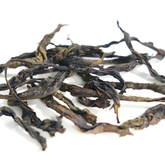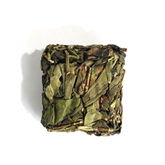What Type Of tea Is Lipton Tea?Caffeine Levels, Additives, and Health Impacts | NPTEA
As someone who has spent decades in China's tea industry managing tea supply chains, I'm often asked: "What kind of tea is Lipton really?" Due to British afternoon tea culture's penetration, many enthusiasts mistakenly believe that Lipton's tea bags hold black tea. But the shock is: This tea industry giant (with a 14% share of the global tea market according to 2024 UN figures) uses industrial blending methods contrary to China's age-old tea artisanal heritage. Unilever's 2022 report tells us that 1,500 Lipton tea bags are sold every second – 130 million a day. But when you glance at the yellow, green, and red boxes on supermarket shelves, you may wonder: what actually does make them so distinct? Actually, Lipton has nothing to do with single-estate teas. It's the poster child of standardized blending – blending leaves from regions and process to create consistent flavors at economic costs. Keep reading to discover the secret code of Lipton's tea mixtures and how this empire was established.
Unilever's 2022 report tells us that 1,500 Lipton tea bags are sold every second – 130 million a day. But when you glance at the yellow, green, and red boxes on supermarket shelves, you may wonder: what actually does make them so distinct? Actually, Lipton has nothing to do with single-estate teas. It's the poster child of standardized blending – blending leaves from regions and process to create consistent flavors at economic costs. Keep reading to discover the secret code of Lipton's tea mixtures and how this empire was established.
The Quick History of Lipton Tea Bags

Then came Thomas Lipton. In 1888, he bought 5,500 acres of Ceylon tea estates and revolutionized production with the CTC (crush-tear-curl) process—leaf processing into uniform granules. This raised yields by 40%. Coupled with cotton tea bags for portion control, Lipton cut prices: half a kilogram of black tea dropped from 3 shillings to a paltry 1 shilling. By 1900, Lipton dominated 37% of the market, the first daily tea brand affordable to the working class.
Lipton's Core Product Lines
Lipton's Top Tea Lines in the U.S. Market:
| Product Line | Ingredients & Process | Flavor Experience | Controversies/Limitations |
| Yellow Label Classic |
- CTC-processed black tea (BOP grade) - Sourced from Kenya/Argentina - 89% Rainforest Alliance Certified |
- Bold malt flavor - Strong yet smooth when iced - Perfect for sweet Southern-style iced tea with lots of sugar and ice |
- 2021 lawsuit over "natural flavor" claims (settled out of court) - Gritty texture complaints |
| Pyramid Premium |
- Whole-leaf tea (OP1 grade) - Rainforest Certified Brazilian farms - Nitrogen-flushed packaging |
- English Breakfast: Smoky wood notes with a sweet finish - Cold Brew variants: Naturally sweet - Richer layered taste than Yellow Label |
- $0.45 per bag (3× Yellow Label price) - Lemon flavor contains 11 additives |
| Herbal Blends |
- Caffeine-free - USDA Organic Certified - Made in California facilities |
- Mint Chamomile: Cooling honey undertones - Turmeric Ginger: Spicy kick - Berry Hibiscus: Tart base for TikTok mocktails |
- FDA warned against "sleep aid" claims (2023) - 2022 ginger pesticide recall |
Caffeine in Lipton Tea
The caffeine content in Lipton tea bags isn’t random—it’s carefully engineered. Three factors control it:
- Tea leaf variety (like bold Assam vs. milder Kenyan),
- CTC processing (crush-tear-curl method that chops leaves into granules, speeding up caffeine release),
- Blending ratios and additives (more tea dust = stronger caffeine kick).
By tweaking these elements, Lipton creates everything from zero-caffeine herbal teas (think chamomile or peppermint) to high-octane black teas designed to jolt you awake. The table below gives a rough idea of how much caffeine you’ll find in their popular products.
| Product Category | Example Products | Caffeine per 240ml Cup | Why the Caffeine Level? |
| Classic Black Tea | Yellow Label Black Tea | 58-62 mg | Uses Kenyan CTC tea (high-caffeine) blended with Assam tea. Hot water boosts extraction. |
| Cold Brew Black Tea | Black Iced Tea (Cold Brew) | 65-70 mg | Extra-fine tea bits + instant tea powder. Works fast even in cold water. |
| Green Tea | Pure Green Tea | 35-40 mg | Steamed Chinese green tea leaves. Less caffeine loss due to processing. |
| Herbal & Fruit Blends | Chamomile Herbal Tea | 0 mg | Made from non-tea plants (like chamomile or rooibos). Naturally caffeine-free. |
| Organic Black Tea | Organic Black Tea | 45-50 mg | Whole-leaf tea from mid-altitude farms. Gentle caffeine release. |
| Energy Boost Teas | Energy Charge Tea | 75-80 mg | Combines guarana extract (natural caffeine) with green tea for a double kick. |
| Decaf Black Tea | Decaf Black Tea | ≤5 mg | Caffeine removed using CO₂ technology. Keeps most tea flavors. |
Data sources: Lipton Global Nutrition Lab Report (2023), ConsumerLab Independent Testing (2022), United States Department of Agriculture (USDA) Tea Composition Database.
Do Lipton Tea Bags Contain Plastic?
The issue is at the intersection of food safety, materials science, and environmental regulation. According to independent laboratory analysis and company reports, material in Lipton tea bags varies by product line and geography. The controversy centers on two ingredients: polypropylene (PP) sealing adhesive and PET plastic used in pyramid-shaped tea bags A 2019 study conducted by McGill University in Canada discovered that some common Lipton tea bags shed around 11.6 billion microplastic particles per cup when steeped in 95°C (203°F) water, primarily from the polypropylene seals (melting point: 160°C/320°F). Even though these tea bags comply with today's legal standards—such as keeping below the FDA's daily tolerance level of 0.01mg per kilogram body weight—their levels of microplastic emissions, while legal, could still raise an eyebrow.
A 2019 study conducted by McGill University in Canada discovered that some common Lipton tea bags shed around 11.6 billion microplastic particles per cup when steeped in 95°C (203°F) water, primarily from the polypropylene seals (melting point: 160°C/320°F). Even though these tea bags comply with today's legal standards—such as keeping below the FDA's daily tolerance level of 0.01mg per kilogram body weight—their levels of microplastic emissions, while legal, could still raise an eyebrow.
If you are worried about potential exposure to microplastics, refer to the table below as a shopping guide.
Pyramid Tea Bag Material Differences:
| Tea Bag Type | Material Composition | Plastic Content | Heat Resistance |
| Standard Square Bags | Paper fibers + polypropylene glue (6%-8%) | 11-14mg per bag | Releases microplastics at high temps |
| Silky Pyramid Bags | Food-grade PET (polyester) | 20-25mg per bag | Stable below 120°C (250°F) |
| Plastic-Free Bags | Corn fibers + plant-based glue (e.g. potato starch) | 0mg | Compostable (breaks down in 3-6 months) |
Do Lipton Tea Bags Expire?
Lipton tea bags typically have a shelf life of 18–24 months when stored unopened in a cool, dry place. The exact expiration date is printed on the packaging (e.g., "Best Before: MM/YYYY"). While dry tea doesn’t technically "expire," its flavor and aroma degrade over time.
Key Recommendations
Check for Signs of Spoilage: Discard tea bags if you notice:
Mold (fuzzy spots or discoloration)
Off smells (musty, rancid, or chemical-like odors)
Insect infestation (tiny holes or webbing).
Storage Tips:
Transfer tea bags to an airtight container away from heat, moisture, and sunlight.
Avoid storing near spices or coffee (tea absorbs odors easily).
Safety Note:
Even if expired, tea without visible mold is likely safe to drink but may taste bland or bitter. Herbal blends with fruit pieces (e.g., berries) spoil faster—use within 6 months of opening.
Pro Tip: For maximum freshness, buy smaller packs and use within 12 months!
SEE MORE
If you have questions about selecting tea:
Learn-more-about-chinese-tea
If you have questions about the benefits of tea:
Health-benefits-of-chinese-tea
If you have questions about brewing tea:
How-to-brew-loose-leaf-tea






